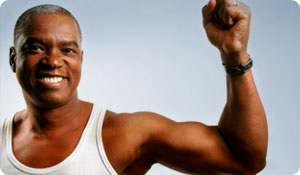
Everyone knows the stats showing that men die younger than women. Today, on average, women survive men by over five years, according to the Centers for Disease Control. The biggest problem that men have is not so much a specific disease, says Dr. Jean Bonhomme, board member of the Men's Health Network, but the diseases are the result of lack of health care monitoring earlier in life.
Whether your goal is to look better, feel better, be stronger, or live longer, the following exercise tips will help you move toward achieving your goals.
Over 40 Exercise Tips for Men
Cardio/Aerobic Exercise. Heart disease is the number one killer of men. According to the Centers for Disease Control, one in four men has some form of heart disease. Increasing age, physical inactivity, obesity and being overweight, high cholesterol and high blood pressure are all risk factors for heart disease. Studies have shown that you can help prevent the development of heart disease through regular exercise, and in particular, with cardio workouts. Cardio workouts burn calories quickly and help you shed pounds. Incorporate any of the following--running, biking, swimming, rock climbing, power yoga, or any other cardio exercise--into your schedule for a minimum of 30 minutes at least 4 times per week.
Weight Training. Once you hit 40, your body starts producing less testosterone, which in effect can decrease your muscle mass. In order to avoid decreasing muscle mass, incorporate weight training into your exercise plan. Not only will weight training increase your muscle and bone mass, it will increase your muscular strength, power and endurance--something we all need after age 40. If weight training is new to you, it is best to begin under the instruction of a personal trainer. Incorporate weight training into your schedule at least 2 times per week.
Pushups and Crunches. As men get older, bellies tend to get bigger, resulting in abdominal fat that increases the risk of heart attack, stroke, type 2 diabetes and certain types of cancers. Along with cardio exercise and weight training, crunches and pushups are a great way to avoid putting on the risky belly fat. Pushups and crunches can be performed at home in the morning or before bed, or at the gym using equipment (or on the floor). Talk to a trainer about proper technique to get the most benefit from the exercises. Incorporate pushups and crunches into your schedule at least 3 times per week.
Stretching. As we age, our flexibility decreases. After age 40, stretching is important for better flexibility, injury prevention and improved performance. Stretching not only keeps your body flexible, but it also promotes joint health and prevents stiffness, aches and pains that tend to creep up on as we age. Take a yoga class at the gym or your local yoga studio to learn proper stretching technique. Once you've taken a few classes, you can begin a stretching regiment on your own or sign up for a series of yoga classes to keep the discipline. Incorporate stretching and/or yoga into your schedule at least 2 times per week.
Nutrition. Any exercise program is remiss without a healthy diet to go along with it. Just as muscle and bone mass decreases over 40, so does your metabolic rate. Excess weight will increase your risk of heart disease, stroke, diabetes and certain cancers. If you are eating a poor diet of highly saturated fats, alcohol, sugars and processed foods, it's time to make the change. Practice good nutritional habits by eating plenty of vegetables, fruits, nuts, a variety of whole grains and lean meats.
Note: Always keep in mind that the point of exercise is to improve the health of your body, not to put it at risk. Make sure you do not over train, especially during periods of stress or illness. When you over train, you run the risk of injuring yourself.
Keep your doctor updated on your exercise regimen. Your doctor can give you valuable advice regarding your body's current fitness level and which exercises you may need to focus be living at your optimum health. Remember -exercise can be one of the most effective methods of ensuring you a good quality of life.
Sources
Mayo Clinic Staff. Men's Health: preventing your top 10 risks. MayoClinic.org. http://www.mayoclinic.com/health/mens-health/MC00013. Accessed Dec. 22, 2009.
Staying Healthy after 40. AOLHealth.com. http://www.aolhealth.com/health/mens-health/advice-for-men-over-40. Accessed Dec. 22, 2009.
Stretching Exercises. Men's Health. http://www.menshealth.com/men/fitness/muscle-building/stretching-exercises/article/472a99edbbbd201099edbbbd2010cfe793cd. Accessed Dec. 22, 2009.
Zamora. D. Men's Top 5 Health Concerns. WebMD.com. http://men.webmd.com/features/mens-top-5-health-concerns. Accessed Dec. 22, 2009.





